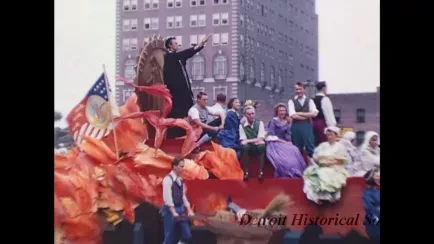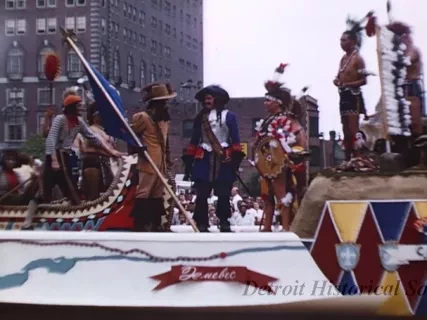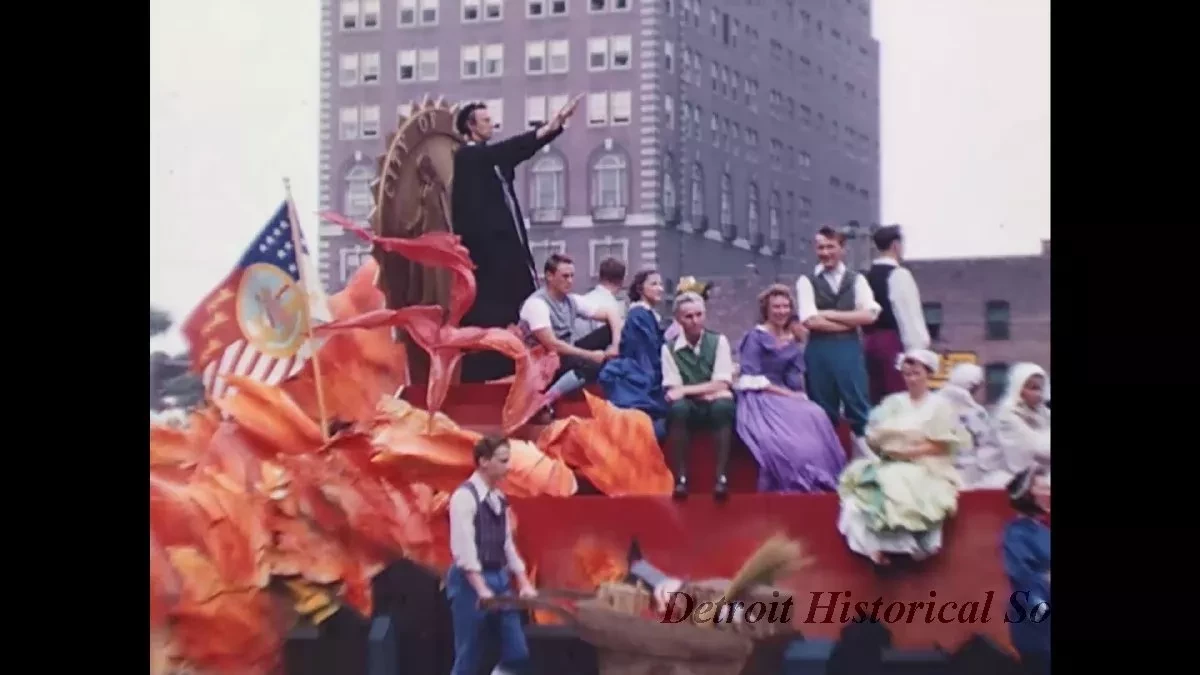Film, Motion Picture
Silent color 16mm home movie containing footage from Detroit's 250th Birthday Festival parade on Woodward Avenue, as well as some shots of hunters and people on vacation.
The reel begins with two shots of a man in a red coat with two horses, standing outside of a stable as snow falls. This is followed by several shots of a dead deer tied to the hood of a teal c. 1950 Oldsmobile. Several men pose beside the deer. This is followed by shots of a man holding a fish in front of a building's porch, as a woman leans outside of the door in the background. A group of people are on a small wooden barge on a river in the following brief shots. Next is numerous shots of a bear in a cage playing and being fed fish. There also shots in between of a deer in a similar cage. The final part of this portion of the reel is footage of cliffs along a shoreline, and people walking along the rocks on the cliffs.
The portion of the reel devoted to the 250th Birthday Festival then begins. This footage was primarily shot from the west side of Woodward Avenue between West Columbia Street, and Elizabeth Street. Sundra's Restaurant, Carter Electric Store, the Downtown Y.W.C.A. building, and the Elwood Bar are among the businesses in the background. The first shot of the parade is of a group of elephants draped with Yellow and red Pfeiffer's beer banners, and wearing head dresses.
They are followed by a clown pushing a wicker stroller. She holds a briefcase, and a parasol, both bearing the name of the Rox Products Company. The next shots are of men and women in turn-of-the-century costume riding bicycles. Some bikes are modern, while others appear contemporary to their costume. One man rides an ordinary bicycle.
The first of the sponsored historical floats to appear is that of the Michigan Consolidated Gas Company. Aboard this float, men and women in turn-of-the-century costume pose around a small gazebo filled with a brass band clad in red uniforms.
Michigan Bell Telephone Company float is next. This float recreates the pharmacy of Frederick Stearns where a telephone was installed just over a year after Alexander Graham Bell patented the invention. The float features a Jefferson Avenue street sign, the facade of the pharmacy, a sign that reads, "Come in and talk over the speaking telephone," and people in late 19th century costume gathered around the device in the cut-away interior.
People in historical costume ride in a red Model T touring car ahead of the next float--that of the Ford Motor Company. This float depicts Henry Ford outside of his Bagley Avenue workshop with his Quadricycle, a man, woman, a bicycle, a wagon wheel, and a statue of a horse. The walls of the workshop are cut away to reveal the tools inside. A banner around the base of the rear of the float reads, "From humble beginnings such as this came the first motor cars."
Shots of four early automobiles, including a pair Curved Dash Oldsmobiles are next. They are followed by the Oldsmobile float, A sign on the side of the float reads "Beginning of Mass Production." Aboard the float, workers in period costume assemble Curved Dash Oldsmobiles, while a group of people pose around a completed one near the rear. "1901" is printed on signs hung from the back of the float.
A horse drawn stage coach representing the Railway Express Agency is next in the parade. It is followed by marching police officers, columns of mounted police, and police on motorcycles. Afterward, Governor G. Mennen Williams and two other men--likely including Mayor Albert Cobo--wave from the back of an aqua 1951 Packard 250 convertible.
They are followed by representatives of the Canada and its military--including the Royal Canadian Mounted Police on horseback, members of the Royal Canadian Navy, the Royal Canadian Army, and a Canadian military band. The members of this band wear several uniforms. A group of drummers wear red military dress uniforms with Wolsley helmets. They are followed by two groups in Scottish highland dress with kilts, as well as a group of soldiers in kilts marching with rifles, and boys in campaign hats and kilts. At the end of the group are women in beige uniforms and hats, possibly from the Canadian Army Women's Corps.
The next participants in the parade captured on film are three women in evening gowns holding bouquets while waving from the rear of a peach 1951 Cadillac convertible.
They are followed by people in costume representing the region's historic soldiers. There is a man marching in a leather fur trapper costume with a coonskin cap and a rifle, a man in a colonial era green military uniform with a rifle, a man in a Civil War-era uniform, another in a Spanish-American War-era uniform, and a man in a World War I-era uniform. They are followed by three men in World War II-era uniforms carrying a banner. Behind them are an M4 Sherman tank, two cast-hull M4A1 Sherman tanks, an M32 Tank Recovery Vehicle, and an M3 Half-Track. The marching band of Thomas A. Edison American Legion Post 187 followed behind, clad in green and yellow uniforms.
The next float is from Cunningham's Drug Store, and it features a mechanical figure of Jumbo the elephant in a cage. It is followed by a float representing Northville. This float includes a covered well, and people seated around a picnic table. A sign on the rear of the float declares Northville the "Switzerland of Wayne County."
Shriners compose the next block of the parade. A group of men march with a "Moslem Detroit" banner beside Ko-Ko the stuffed camel, who is pulled along on a wheeled platform by a tiny car. There is also a marching band clad in turbans, capes, billowy pants, and pointed shoes, as well as men clad in suits and fezes.
The next group marching in the parade wear dark uniforms topped by bicorn hats with while crests. They are followed by the marching band from St. Mary's Chinese School, who wear red and yellow uniforms.
People from Greek groups comprise the next contingent of marchers. Some wear folk costume, others wear military uniforms, a group of women march in togas, and two shirtless men march in shorts.
The film then briefly returns to the hunters. A gutted deer hangs from a tree in a rural area, as various men pose beside it.
The film returns to the parade with the General Motors float, which represents the United States taking possession of the city on July 11, 1796. Colonial soldiers, and the Liberty Bell are on the float, and more soldiers march behind the float.
The following float, from the Detroit Edison Company, represents the Fire of 1805. The base of the float is painted to show burning buildings, and the rear of the float is decorated to resemble billowing flames. People in period costume ride and walk beside the float. A group of men stand around a document near the front of the float, and a man in dark clothes with his arms outstretched is on a platform near the rear of the float in front of a large version of the city seal.
The Saks Fifth Avenue float is next. It is decorated with emblems and flags representing France, the United States, and Great Britain, and carrying people dressed in early 19th century formal attire in a court scene.
It is followed by the Kelsey-Mayes Wheel Company float which is in the form of the Great Lakes' first steamship, the WALK-IN-THE-WATER.
Next is the Booker T. Washington Trade Association's float, which commemorates the Underground Railroad. People in period costume pose along the multi-tiered float, and at the rear is a model of the "John Brown House" (the home of William Webb where John Brown, Frederick Douglass, George deBaptiste and others met in on March 12, 1859) at 185 East Congress Street.
Afterward is the Lincoln-Mercury float, upon which a man portraying Abraham Lincoln stands at the rear above a banner with his quote, "Thank God for Michigan." The float also carries a group of men in Union army costume, and a miniature encampment.
A second Ford Motor Company float follows. This one represents Fort Wayne. Men in Civil War uniforms, and women in period dresses stand amid representations of the fort's walls and buildings.
It is followed by a float representing immigration. "Give me Your Tired - Your Poor" is written along the side of the float below people in various European folk costumes who sit amongst flowers. A women dressed as Liberty stands among a semi circle of flags at the rear. This float is followed by a sad tramp clown, a group of fifers, and then the Pfeiffer's elephants from the beginning.
The film is on a 7" metal reel inside of a blue tin.
Request Image


